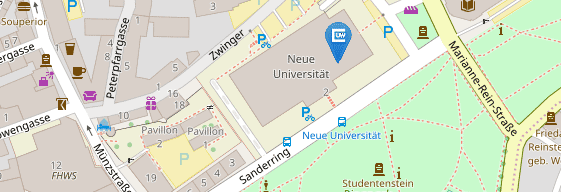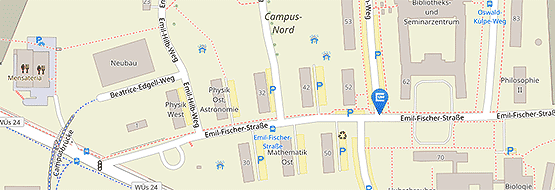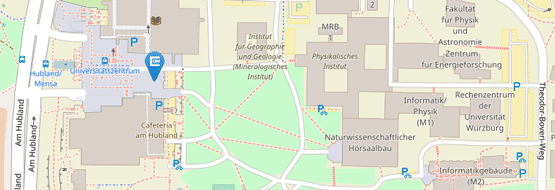PUMA : Voltage Lab
The "PUMA : Voltage Lab" application supports learners in developing correct conceptual knowledge of electricity. To do this , models of the electrical circuit are presented to match the experiments carried out by the students. This approch makes it easier and more intuitive to link observations made in the experiment (e.g. the brightness of a lightbulb) with their physical cause (e.g. the intensity of the flow of electrons through the light).
The application offers the option of either projecting the model ideas over a real circuit using augmented reality (AR) or creating a virtual circuit in a simulation and enriching it with the model visualizations.
Preparation
One of the following experiment systems is required to use the app in AR mode:
- Electrics 1 experiment kit from MEKRUPHY (Link: mekruphy.com/de/produkte/physik/elektrik-elektronik/experimentiersatz-elektrik-1/)
- Grid plug-in plate DIN A3 & plug-in elements STE 2/19 from LD Didactic
The materials must be prepared to be identified by the app. To do this, each component is labelled with a QR code-like target. The templates and instructions can be found here:
The following material is required for the additional use of the data recording and display:
- phyphox:e wireless sensor box from phyphox
Contents
The application extends a real circuit by displaying the conduction electrons and visualising the electrical potential (by colouring or shifting the conductor pieces). To do this, the app uses the component targets to identify the test setup and superimposes the displayed live camera image with virtual representations of the model ideas. In addition to visualising the moving electrons and potentials on selected components, the app also provides a view on the particle level. In accordance with the impact model of electrical resistance, the interactions of the conduction electrons with the atomic bodies of the components can be observed here.
In addition to these qualitative observations, the use of the wireless sensor box enables the display of measurement data collected on the real circuit. The real data is also used in conjunction with the known characteristic resistance values to calculate the voltage drop and current for each component. The app can therefore be used for quick quantitative testing of more complex circuits.
If the full range of functionalities is utilised, the app can accompany the entire process of gaining knowledge in electricity theory - from the first simple circuit to series and parallel circuits and combinations of these.
Quick test
Please download the app, enlarge the image with one click and try out the app by scanning the QR codes using the example of the photographed circuit.
Contents
In the app, learners can create their own digital circuit. Based on the real experimental systems, components are placed on the virtual breadboard using drag & drop. Once the circuit has been built, the app expands it with representations of the conduction electrons and visualisations of the electrical potential (by colouring or moving the conductor pieces). In addition to visualising the moving electrons and potentials, selected components provide insights into the processes at particle level. In accordance with the impact model of electrical resistance, the interactions of the conduction electrons with the atomic bodies of the components can be observed here.
The digital simulation enables learners to prepare and follow up the experiments and lesson content at their leisure, even outside of school. This makes the app a learning companion in class and at home - from the first simple circuit to series and parallel circuits and combinations of these.
Quick test
As no additional hardware is required to use the simulation, you can simply download the app and start it straight away.
Rod/marble run model
Developed at the Ludwig Maximilian University of Munich, the rod model is based on a height analogy of the electrical potential. Accordingly, areas of the same electrical potential are represented at the same height above the circuit. The electrical voltage can therefore be understood as a measure of the difference in height. Additional information and (teaching) materials on the rod model can be found here (Link: https://lehrerfortbildung-bw.de/u_matnatech/physik/gym/bp2016/fb5/7_elektrizitaet/2_ueberblick/1_modell/).
The marble run model, which is also based on the height analogy, extends the static rod model to include moving marbles that move along the lines following the gradient. Compared to the rod model, this makes it easier, for example, to qualitatively analyse the node rule.
Electron gas model
The electron gas model draws meaningful connections between the electrical potential and the air pressure. Similar to an air pump, a battery or a power supply unit attempts to generate a difference in (electron) pressure in the connected areas. If the areas are connected to each other, a stream of particles equalises the pressure. Additional information and (teaching) materials on the electron gas model can be found here (Link: https://www.einfache-elehre.de/).
Impact model of electrical resistance (Drude model)
P. Drude modelled electrons as a gas in 1900 (P. Drude, Annalen der Physik 1, 566 and 3, 369). The outer electrons of a metal can move freely in this model, the atomic cores remain stationary, whereby collisions between electrons and atomic cores are permitted. This simple classical model allows, for example, the derivation of qualitative aspects of Ohm's law. You can find more information e.g. here (link: https://qnap.e3.physik.tu-dortmund.de/suter/Vorlesung/Festkoerperphysik_WS12/5_Elektronen.pdf)
Explanatory video on voltage in an unbranched current circuit (video)
Explanatory video on how to use the AR mode of the app (video)
Materials for group work with the app(pdf )
The materials contain four stations on the topics of "Current and voltage", "Electrical resistance", "Parallel circuits" and "Series circuits".
AR-supported teaching unit for electricity lessons in year 8 at grammar school:
Tabular overview of the teaching unit(pdf)
Lesson script for the pupils (pdf)
Lesson script in the teacher's version (pdf)
As part of a doctoral thesis at the Department of Physics and its Didactics, the app was analysed in a student laboratory to determine its suitability for learning. To this end, the use of the simulation mode and AR mode was compared with the use of conventional materials and the influence on the development of concept understanding, the cognitive load perceived during the learning process and the working time spent on learning was analysed (see publications of the chair).
Contact us
Please contact the persons responsible if you have any questions, suggestions or notifications of errors:
Conception, implementation and accompanying research Dr Christoph Stolzenberger
Conception and student lab research Florian Frank









